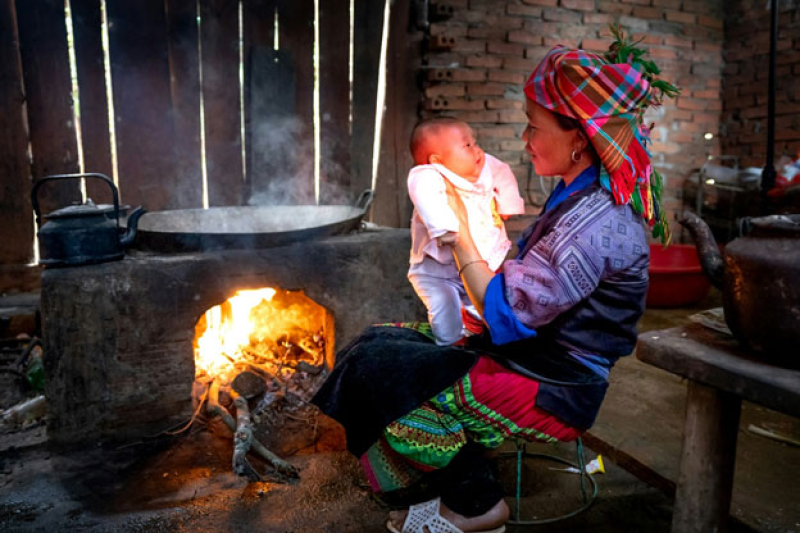- Khagrachhari violence: 3 cases against 1, 000 unknown people |
- Durga Puja ends today thru immersion of idol |
- Bay Deep depression likely to cross Odisha by Thursday night |
- Human Rights Groups Urged to Unite Against Racism |
- UN, Civil Society Urge Action on Rohingya Rights in Myanmar |
Asia-Pacific’s Challenge: Clean, Affordable Energy by 2030

An Asian mother is taking care of her baby while cooking with traditional stove. Approximately one billion people in Asia and the Pacific still rely on traditional polluting cooking fuels that lead to poor indoor air quality.
The future of the global energy landscape will be shaped by Asia and the Pacific. Over the past two decades, the region has been the principal driver of global energy demand and emissions. Energy has powered prosperity, lifted millions out of poverty, and transformed societies.
This progress, however, has come at a cost: widening inequalities, entrenched fossil fuel dependency, and increasing climate vulnerability – making the achievement of the Sustainable Development Goals (SDGs) and climate objectives more difficult.
What will it take for the region to achieve the energy transition and meet SDG 7 – clean, affordable, reliable, and modern energy for all – by 2030? The new Regional Trends Report on Energy for Sustainable Development shows that universal access to electricity is within reach. Yet other dimensions of sustainable energy require urgent acceleration.
Clean cooking remains the most pressing challenge. Nearly one billion people in Asia and the Pacific still rely on traditional fuels, exposing households – especially women and children – to dangerous levels of indoor air pollution. Renewable energy is expanding, but still falls short of the pace needed to meet rising demand and cut emissions at the required scale.
Per capita, Asia and the Pacific’s installed renewable energy capacity remains lower than in other regions. At the same time, energy efficiency is underutilized, leaving untapped potential to reduce consumption, cut costs, and lower carbon emissions.
These challenges are compounded by emerging pressures. Securing access to and sustainably developing critical raw materials is essential for advancing energy transitions, while expanded regional power grid connectivity is crucial to improving energy security and keeping electricity affordable.
Rapidly growing sectors, such as data centres, also need to shift toward low-carbon pathways. Meeting these priorities will demand strategic planning, coordinated action, and a strong commitment to fairness and equity.
The Asia-Pacific region has shown encouraging signs in recent years, with many new initiatives to draw inspiration from. Subregional projects, including the ASEAN Power Grid and the Nepal-India-Bangladesh trilateral power trade, are fostering cross-border electricity exchanges, improving reliability, and enabling greater renewable integration.
China and India are at the forefront of renewable energy, while Pacific countries such as Fiji, Solomon Islands, and Vanuatu have set targets for 100 percent renewable electricity by 2030. Indonesia and the Philippines are expanding geothermal capacity. Grid-scale battery storage in Australia is helping manage renewable fluctuations and strengthen system resilience.
Industries, urban centres, and the transport sector are also driving change. Countries are rapidly expanding the adoption of electric vehicles through investment and infrastructure. Japan and Singapore are improving building energy efficiency with strict standards and incentive programmes, while the Republic of Korea is deploying smart grid technologies to optimize usage.
These examples illustrate that innovation, investment, and cooperation are creating the conditions for scalable energy progress across the region.
The energy transition is not only a technological shift but also a social transformation. For many – such as workers in fossil fuel industries, households living in energy poverty, and youths entering the job market – the transition will be a lived reality. Reskilling, education, and social protection must accompany this shift, while decent jobs in renewable energy and energy efficiency sectors are created.
Women are disproportionately affected by energy poverty and remain underrepresented in the energy workforce and decision-making roles. Unlocking women’s full participation in the sector is essential to accelerate innovation and inclusive growth. A just energy transition must be gender-responsive, with policies and investments designed to close gaps in access, employment, and leadership.
Three priorities stand out:
Ambition in policy and planning. Countries need bold, integrated policies that align national energy plans with climate commitments, including net-zero targets. This means setting higher renewable energy ambitions, phasing down coal dependency, embedding energy efficiency across all sectors, and ensuring policies are just and inclusive.
Scaled-up investment. Delivering SDG 7 requires mobilizing trillions in sustainable energy investment. Governments alone cannot bear this burden. De-risking mechanisms, innovative financing, and public-private partnerships will be critical to unlock capital flows.
Regional cooperation. Regional grid integration, cross-border power trade, and shared approaches to developing critical energy transition minerals and technology standards can create efficiency and resilience.
The region has shown that transformative change is possible. Just 20 years ago, hundreds of millions lacked access to electricity. Today, universal access is within reach – proving that the seemingly insurmountable gaps in clean cooking, renewable deployment, and energy efficiency can be overcome with decisive political will and bold action.
As Asia-Pacific countries gather in September at the ESCAP Committee on Energy, the message is clear: we must act with urgency, ambition, and solidarity – or risk being locked into high-carbon pathways. The decisions made in the coming years will define the region’s energy future well beyond 2030.

